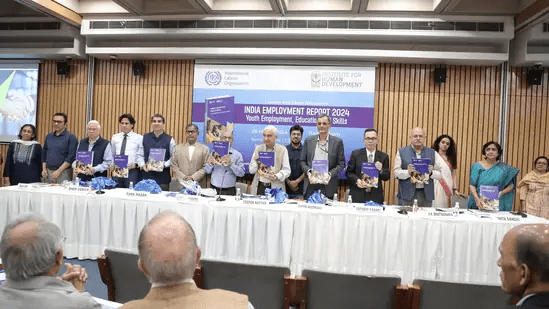
A report released recently by the International Labour Organisation (ILO) and the Institute of Human Development (IHD) reveals concerning trends in unemployment in india. The report highlights that nearly 83% of the unemployed workforce in India consists of young people.
The proportion of educated youths among the unemployed has almost doubled from 35.2% in 2000 to 65.7% in 2022, according to the report.
The report, released by Chief Economic Adviser V. Anantha Nageswaran, indicates that youth employment and underemployment have increased steadily since 2000, although there was a temporary decline during the pandemic. This rise in unemployment is particularly pronounced among educated youths.
Key labor market indicators such as the Labour Force Participation Rate (LFPR), Worker Population Ratio (WPR), and Unemployment Rate (UR) have deteriorated significantly between 2000 and 2018. However, there has been a slight improvement post-2019, coinciding with periods of economic distress. Yet, the authors of the report caution that the reasons behind this improvement warrant careful analysis.
The report underscores the persistent issue of insufficient growth in non-farm sectors, which fail to absorb workers transitioning from agriculture. Despite non-farm employment growing at a higher rate than farm employment before 2018, the absorption of labor from agriculture remains a challenge, with construction and services sectors being the primary absorbers.
Moreover, the majority of workers, around 90%, are engaged in informal work. While the share of regular employment increased until 2018, it has since declined, worsening livelihood insecurities. Additionally, there’s been a rise in contractualisation, leaving only a small percentage of workers covered by long-term contracts.
The report paints a bleak picture of the skill gap among India’s youth. Despite being a demographic dividend, many young people lack essential skills for today’s job market. Shockingly, 75% of youth are unable to send emails with attachments, 60% struggle with copying and pasting files, and 90% cannot input a mathematical formula into a spreadsheet.
This lack of quality employment opportunities leads to high levels of unemployment, particularly among educated youth who are hesitant to accept low-paying, insecure jobs. The gender gap in the labor market is also a significant concern, with low rates of female labor force participation, especially among highly educated young women.
The report also sheds light on social inequalities, indicating that despite affirmative action and targeted policies, Scheduled Castes and Scheduled Tribes still face barriers to accessing better jobs. These groups often engage in low-paid temporary casual wage work and informal employment, despite improvements in educational attainment.
The report also underscores the deep-rooted challenges in India’s labor market, worsened by a lack of quality employment opportunities, skill mismatches among youth, and persistent social inequalities. Addressing these issues requires comprehensive policy interventions aimed at fostering inclusive growth and providing adequate support for skill development and job creation, ultimately placing the onus on the government to enact meaningful change.
Congress on Wednesday targeted the Modi government over unemployment, citing the report.
“ILO and IHD report conclusively says that the unemployment problem is grim in India. We are sitting on a ‘ticking bomb’ of joblessness! But Modi government’s chief economic advisor protects the dear leader, by saying ‘government can’t solve all social, economic problems such as unemployment’,” said Congress president Mallikarjun Kharge.
AICC communication in-charge Jairam Ramesh flagged some “extremely concerning facts” in India’s labour market over the past 10 years, as per the report.
“Each year, around 70-80 lakh youths are added to the labour force, but between 2012 and 2019, there was almost zero growth in employment – just 0.01%! In 2022, unemployment was very high among the urban youth (17.2%) as well as rural youth (10.6%). The female unemployment rate in urban areas was extremely high at 21.6%,” said Ramesh.
“This report finds that the Modi government increased the percentage of low-paying informal-sector employment without social security, while formal employment decreased from 10.5% to 9.7% from 2019-22,” he added.



